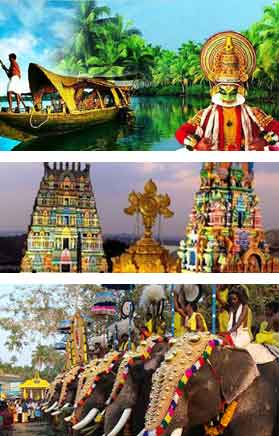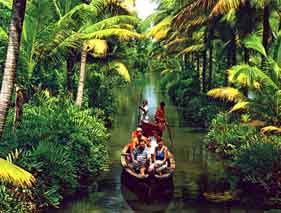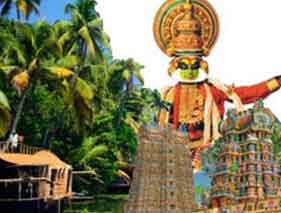Itinerary Details
Day 1 ARRIVE BANGALORE:
Arriving Bangalore You are met outside the Domestic Arrivals Hall and transferred to Hotel.
After freshening up, spend the day exploring Bangalore, the capital of the state of Karnataka, which offers the graceful charms of a well laid out garden city with parks and beautiful buildings. The 'Garden City' has several fine parks; Lal Bagh, the botanical gardens laid out by Haider Ali and his son Tipu Sultan in the 18th century, is the loveliest spot in Bangalore. Extending in terraces for over 240 acres, the garden has centuries-old trees, lakes, lotus pools, rose gardens, a deer park and an assortment of tropical and subtropical herbs and plants. The pretty glass house in the centre is the venue of the bi-annual Horticultural Exhibition. Cubbon Park is an extensive stretch of green sprawling over an area of 300 acres. The imposing red gothic structure within the park is now the public library. Vidhan Soudha is an imposing granite structure built in the neo-Dravidian style and houses the Secretariat and the State Legislature. Its cabinet room has a massive door made from pure sandalwood. The Bull Temple is built in Dravidian style and has a monolithic figure of Nandi, the bull, 15 feet high and 20 feet long. History records that it was built by Kempegowda, the founder of the city. The Museum, located on Kasturba Gandhi Marg, is one of the oldest in India, established in 1886. It houses a varied collection of items relating to archeology, geology, art and numismatics, some items dating back to the time of Tipu Sultan. Dinner and overnight at Hotel.
Day 2 BANGALORE/HASSAN:
After breakfast depart on the drive to Hassan. En route visit Sravanabelagola. Its serenity emanates from the simplicity of its ascetic inspiration and the grandeur of its scale. It is said to be the world's tallest monolithic statue. The hill is one mass of granite about 122 m high and probably had a mass or two standing at its summit - either a part of the subjacent or lying on it. This the Jains undertook to fashion into a statue 17.7 m tall, and have achieved it with marvelous success. Sravanabelagola is wedged between two rocky hills called Indragiri or Vindhyagiri and Chandragiri. The translation of Sravanabelagola is "the white pond of the ascetic". This most probably refers to a pond that once existed where the present temple tank now is, at the base of the Indragiri hill. The ascetic is Bhagwan Bahubali, also known as Tirthankar Sant Gomateshwara, whose huge statue dominates this little village. This is the holiest of all Jain places of pilgrimage. Dinner and overnight at Hotel.
Day 3 HASSAN/MYSORE:
After breakfast visit Belur which was a flourishing city under the Hoysala kings some 800 yeas ago. The Belur temple is star-shaped and embellished with gods and goddesses in all their varied aspects and incarnations, as well as scenes from the great Indian epics. The realities of life are also depicted beautifully in the forms of hunters, dancers, musicians and women at their daily toilette. A series of semi-detached pillars and ornamented porches lend variety to the facade; the artistic combination of horizontal and vertical light and shade and the play of silhouettes far surpasses anything in Gothic art.
Continue on to Helibid which is situated some 16 km from Belur. The main temple, also built in a star-shaped plan is a magnificent example of Hoysala architecture with a breathtaking collection of friezes - first a row of elephants representing stability, then one of lordly lions and above, scrolls of swift horses. There are scenes from the religious epics representing not only philosophical ideas but also the living conditions of the time. The largest frieze is the most exuberant and based on a heavenly theme - celestial maidens, bedecked in jewels, are seen sitting or standing under pierced canopies in graceful postures. The original name of Halebid, the ancient capital of the Hoysalas, was Dwarasamudram, "gateway to the sea". After its sack by the Delhi Sultanate, it came to be known as Halebid, "old Capital". There were many temples and palaces here but few survived the invasion. The magnificent Hoysaleswara temple is very similar to the temple at Belur, though different in detail work. It is set on the same star - shaped platform ascended by a short flight of steps. The palace once stood nearby, connected to the temple by a passage. A Nandi bull, the mount of Lord Shiva, stands guard at the entrance. This temple is about 800 years old, although not wholly in ruins. Only one bracket figure remains, though the relief carvings on the walls are as profuse and complex as at Belur. Among the carvings are scenes of many historical battles, of the child Krishna's frolics, Shiva and Parvati's embrace and Ravana hoisting Mount Kailash. The Hoysalas, traditional enemies of the Chalukyas, ruled this part of the Deccan between the 11th and 13th centuries. They rose to prominence first under leadership of their ruler Tinyaditya and later under king Bittiga, better known as Vishnuvardhana. It was during this period when the Hoysalas established their supremacy that the temples of Belur and Halebid were built.
Continue on to Mysore. En route visit Srirangapatnam, the capital of Haider Ali and his son Tipu Sultan till 1799, when the British captured it. It was here that the Tiger of Mysore, as Tipu was called, fought and died. Outside the ruins of the old fort is Daria Daulat (Splendour of the sea), Tipu's summer palace, set in an exquisite garden. The palace has been converted into a museum and houses some of Tipu Sultan's belongings. The tomb of Tipu Sultan and his parents marks the end of the glorious history of this town. On arrival in Mysore check in at Hotel for dinner and overnight stay.
Day 4 IN MYSORE:
After breakfast explore Mysore the capital of the erstwhile princely state of that name. It is famous for its silk and sandalwood, as well as its numerous palaces, well laid out boulevards and beautiful parks. Visit the Maharaja's Palace, the most impressive of Mysore's ochre-coloured buildings - a modern edifice built in 1897, where the oriental decorative imagination runs wild. One of the largest palaces in India, it is a sort of gigantic synthesis of Hindu and Muslim styles. Entrance gateways, domes, arches, turrets, colonnades, sculptures can be seen here in magnificent profusion. The royal family's private chambers, including the impressive Durbar Hall, are open to the public. The Marriage Hall has life-like paintings of the Dassera procession and in the museum is the ruler's golden elephant throne, used during these festivities. St. Phelomena's Church is a magnificent cathedral, the largest in South India.
In the afternoon visit Somnathpur, the site of the Prasanna Chennakasava temple, built in 1268 AD, with the star-shaped base characteristic of Hoysala temple architecture. The exterior walls are frescoed with narrative passages from the Ramayana, the Mahabharata and the Bagavatha, laid out so exactly, that each segment ends at a door. Vivid with details, no two frescoes are alike. Return to Hotel in the evening for dinner and overnight stay.
Day 5 MYSORE/NAGARHOLE:
After breakfast depart on the 2-hour drive to Nagarhole National Park. On arrival check in at River Lodge.
After lunch depart on a jeep safari into the park which was established in 1955 and extended to its present size of 573 sq. km in 1975. The Kabini river has been dammed to form a large and attractive reservoir which separates the park from the Bandipur National Park to the southeast. Large herds of gaur (the largest of wild oxen), elephants, sambar, cheetal (spotted deer) are among the game found. Leopard and tiger are also occasionally sighted. The park has over 250 species of birds recorded. Dinner and overnight at River Lodge.
Day 6 NAGARHOLE/OOTY:
Early morning game viewing is by jeep or coracle - excellent for bird-watching as well as viewing animals on the banks of the river. There are also several watchtowers where one can spend long interesting hours viewing elephants and other game.
After breakfast depart on the 3-hour drive to Ootacamund, popularly known as Ooty, the leading hill station in South India. On arrival check in at The Monarch. Situated in the heart of the beautiful Nilgiris (Blue mountains) at an altitude of 2,286 m, Ooty offers salubrious air, rolling parkland, gorse-covered downs and trout- filled streams. The hillsides are swathed in eucalyptus and blue gum trees. The Botanical Gardens, which are a landmark in Ooty, have many rare trees and flowering plants. There is a beautiful lake with boating facilities. Ooty is also known for its tea and coffee plantations and there are hundreds of tea estates in and around this hill resort. overnight at Hotel.
Day 7 OOTY/COCHIN:
After an early breakfast depart on the drive to Cochin. On arrival check in at Hotel. overnight at the hotel.
Day 8 IN COCHIN:
After breakfast explore Cochin, which comprises of a cluster of islands and towns. Fort Cochin is believed to be the oldest European settlement in India, with the Portuguese flag first hoisted here in 1500. St. Francis Church, built in 1510 by friars brought to India by Vasco da Gama, is the first European church built in India and is the site where da Gama was buried. While the remains were later taken back to Lisbon, the gravestone can still be seen here. The Jewish Synagogue was built in 1568 and considerably embellished in the mid 18th century by Ezekiel Rahabi, who built a clock tower and paved the floor of the synagogue with hand-painted tiles brought all the way from Canton in China. The "Dutch Palace" was built in the 1550s by the Portuguese and taken over by the Dutch, who later presented it to the Rajas of Cochin. The palace contains excellent mythological murals and a rare example of traditional Keralite flooring - a subtle mix of burnt coconut shells, lime, plant juices and eggwhites - which gives the effect of polished marble.
In the afternoon take a leisurely cruise on the beautiful backwaters of Cochin.
In the evening witness a Kathakali dance performance. This is the most developed dance drama art of India. Drums beckon an audience to a performance most magnificent - actors depict characters from the Puranas and the Mahabharata, the great Indian epics - demons, superhuman beings and ordinary men and women. The dancers, all male, adorn themselves in huge skirts and elaborate headdress, wearing what must surely be the most intricate make up known to any dance style in the world. Dialogue is combined with dance to bring myth and legend to life in the temple courtyards of Kerala. overnight at Hotel.
Day 9 DRIVE TO MUNNAR
After breakfast drive to Munnar. Approx 4 hours drive will take you to this beautiful hill station. Check in at your hotel and later explore the surroundings.
A major center of Kerala’s tea industry and close to Anaimudi, at 2695 m highest peak in South India, Munnar is the nearest Kerala comes to a genuine hill station. It is surrounded by about 30 estates, amount the highest in the world, and the forest that is still rich in wildlife, including the reclusive Nilgiri Tahr that continues to survive the increasing the commercial use of the hills. The surrounding hills are home to the rare Neelakurunji plant (Strobilanthes), which covers the hills in colour for a month once in 12 years. Overnight stay in Munnar
Day 10 IN MUNNAR
Enjoy teh day in Munnar and another overnight stay
Day 11 DRIVE TO PERIYAR
The journey ends at the prosperous town of Kottayam, an important trading centre and the first town in India to attain 100% literacy. Nestled in the foothills of the Western Ghats, it has beautiful backwaters to its west and scenic fertile mountains to its east. A major centre of the trade, Kottayam also has a strong spiritual side to it, with several sects and divisions of the Syrian Christian faith due to the influence of history over the centuries. The best known churches are the historic Valia Palli and Cheria Palli, both with colourful frescoes enriching their dim interiors.
The coach will meet you at Kottayam for the drive to the Periyar Tiger Reserve and National Park. On arrival check in at Hotel Shalimar Spice Garden.
In the afternoon explore the park. Established in 1934 as the Nelliampatty Sanctuary, the park was enlarged in 1950 and is India's southernmost tiger reserve. The lake covers some 10 sq. miles and most of the sanctuary is undulating. Since boat travel is the only means of transport in the park, large areas can be covered in a short time. Among the game found here are gaur (the largest of the world's wild oxen), elephant, wild pig, sambar, barking deer, mouse deer, the rare and endangered lion-tailed macaque, the Nilgiri langur, the common langur and the bonnet macaque, porcupine, Malabar squirrel, wild dog and tiger. Among the birds commonly seen are darters, cormorant, osprey, kingfisher and kite, great hornbill, grey hornbill, hill mynas, orioles and racket-tailed drongos. Dinner and overnight at Hotel Shalimar Spice Garden.
Day 12 PERIYAR /ALLEPPEY:
After breakfast drive to Alleppey, known as the "Venice of the East", situated on the Vembabad Lake, the longest lake in India. A maze of canals and a network of bridges give this busy commercial town its descriptive sobriquet. Alleppey is known for its coir, the retted fiber of the coconut husk and for black pepper. Coir yarn, mats and matting and a wealth of other coir products are manufactured here and are good buys.
Board the Rice Boats to begin a fascinating journey through forests, palm-shaded backwaters and canals. The leisurely cruise on the beautiful backwaters offers magnificent scenery along the waterways and an unique insight into the history, lifestyle, culture and religion of the region. Dinner and overnight on the Rice Boats.
Day 13 DRIVE TO KOVALAM
After leisurely breakfast drive to Kovalam. Stop in Trivandrum to explore the best of it.
The capital of the state of Kerala, Trivandrum or Tiruvananthapuram, is a beautiful seaside city build on hills overlooking quiet verdant valleys. The Padmanabhaswamy Temple is dedicated to the serpent Anantha, on which Lord Vishnu reclines and is a sacred place of pilgrimage for Hindus since antiquity. With its magnificent tower rising in seven storeys against the reflecting pool in front, the temple is a fine specimen of South Indian architecture. Napier Art Museum is a colourful and attractive turreted structure with gothic roof and minarets. The painted walls and ceilings have copies of the Ajanta and Sigirya frescos, miniatures from the Rajput, Mughal and Tanjore schools, works from China, Japan and Bali as well as canvasses by modern Indian painters.
Further 10 - 15 Kms drive will take you to the beach. Check in at your resort and overnight stay.
Day 14 IN KOVALAM
Kovalam Beach is a natural bay, sheltered from high waves and surges. You can experience an Aryuvedic massage, famed for its rejuvenating qualities. Aryuveda is the traditional system of medicine practiced in Kerala for centuries. The potions are prepared from herbs.
Day 15 IN KOVALAM
Another day for relax at your beach resort.
Day 16 DRIVE TO KANYAKUMARI
Morning drive south to reach at the last road end at Kanyakumari. Extreme south of Indian boundaries. Kanya Kumari, the southern-most tip of India, where three seas meet. The shore temple to the virgin goddess Kaniyakumari is one of the sacred places of the Hindus. The temple is magnificently sculpted and the goddess in its sanctum a creation of rare beauty. The Gandhi Mandapam, built in the Kalinga style, commemorates the immersion of the ashes of Mahatma Gandhi in the waters by the temple.
Overnight stay in Kanyakumari.
Day 17 FLY OUT FROM TRIVENDRUM
Morning you will get transferred to the Trivendrum airport in time to board flight for onward destination






